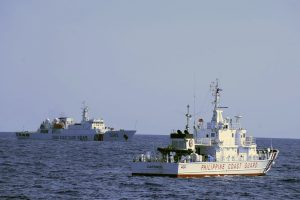Over the past year, the Philippines has been often in the international headlines.
The country’s government has repeatedly expressed its concerns over China’s aggressive actions in the South China Sea, such as a string of confrontations between Chinese coast guard vessels and the Philippine Coast Guard (PCG), most recently in early August.
As a result, Manila has had no choice but to rebalance its relations with Washington, as evidenced by this year’s expansion of the 2014 Enhanced Defense Cooperation Agreement from five to nine mutually agreed military facilities where the U.S. armed forces can operate. China claimed that this move was provocative and destabilizing, and even went so far as to accuse the Philippines of interfering in cross-Strait relations. In response, Philippine Defense Secretary Gilberto Teodoro emphasized that the country, like all countries, has the right to modernize its defense and form alliances without the need for other countries to question this right.
Despite Chinese accusations, Philippine President Ferdinand Marcos Jr. has been sensitive to the need to take diverse approaches to the country’s foreign policy and security challenges. For months, the Philippine president has called for the Association of the Southeast Asian Nations (ASEAN) to conclude negotiations for the Code of Conduct in the South China Sea. He has also expressed support for ASEAN’s maritime initiatives, such as the 17th ASEAN Navy Chiefs Meeting, the 2nd ASEAN Multilateral Naval Exercise, and the Guidelines for Maritime Interaction, in order to build goodwill with regional neighbors at sea.
All of the challenges facing the country point to the need for an overarching strategic guidance that can guide Manila’s activities on the international stage. The National Security Policy (NSP) 2023-2028, released last month, provides exactly this: a policy document that is cautious yet clear-eyed about the country’s position and current challenges. Even as it carefully navigates the uncertain and dangerous security landscape, the Philippine government is coming to better understand this landscape and what to do about it.
According to the document, the Philippines envisions “a free, resilient, peaceful, and prosperous maritime and archipelagic nation, at peace with itself and its neighbors, enabled and protected by a reliable defense and public safety system.” For that to happen, the NSP asserts that a successful policy must start with the “awareness and assessment of the factors and circumstances” that shape Philippine security.
For one thing, the NSP strikes a much more somber tone than the previous documents. U.S.-China competition has been identified as a potential source of conflict, adding further tension to an already volatile situation. The NSP also acknowledges that Russia “invaded” Ukraine in February 2022, affecting food and energy security and weakening international norms. Meanwhile, the West Philippine Sea, Manila’s claimed parts of the greater South China Sea, “remains a primary national interest” as other “claimant countries” repudiate the Arbitral Award that ruled mostly in the Philippines’ favor in 2016. Furthermore, cross-Strait relations have become a “major concern” for Manila as they threaten to undermine “economic stability, a potential influx of refugees, and the welfare of overseas populations.”
Above all, the new NSP deserves praise for hierarchizing the Philippines’ national security interests. The top security interest is none other than national sovereignty and territorial integrity. In turn, the NSP sets “defense and military security” as its core agenda. From what the NSP lays out, the Marcos government recognizes the importance of a credible defense posture, which is a critical enabler of other national security interests, such as human security and political unity.
The Philippine government has already laid out ways and means to pursue these goals. These include embracing the multidomain warfare concept; integrating military with diplomatic, economic, and social tools of statecraft; aligning said tools of statecraft with its U.S. ally and other partners for capacity-building, planning, and interoperability; developing its reserve force for humanitarian assistance and disaster response; employing the Armed Forces of the Philippines (AFP) solely towards external defense; and revitalizing the Self-Reliance Defense Posture program.
In terms of sustaining the country’s top security interest, China’s relentless moves in the South China Sea are doing the Philippines a favor in forcing it to take defense seriously as a branch of foreign policy. For instance, Marcos vowed that his government would respond to Beijing’s latest “10-dash line” map, starting with a diplomatic protest. In early August, the Philippine Senate adopted a resolution condemning China’s actions in the South China Sea and strengthening unilateral and multilateral measures to give that condemnation force. But the real battle will come with legislative measures to finance the AFP and PCG modernization programs in order to address logistical and material gaps.
There are other challenges as well. In August, China and the original members of the BRICS economic bloc welcomed Saudi Arabia, Iran, Ethiopia, Egypt, Argentina, and the United Arab Emirates as new members. The Philippines may want to capitalize on the economic opportunities of closer relations with BRICS by following suit, but this might complicate matters in the politico-security realm. Manila, therefore, must engage in serious diplomacy to pressure its American ally into putting more legwork into addressing the gaps in the Indo-Pacific Economic Framework for Prosperity, in order to complement its existing military-centric assistance and preventing Washington from losing ground in Southeast Asia.
One foreign policy analyst recently observed that the Marcos administration has managed to detoxify the Philippine establishment following what many viewed as his predecessor’s policy of appeasement toward China. While true, the present administration can only be assessed against its own standards from here on out. Only time can tell whether Marcos exceeds this administration’s current performance by achieving its desired ends and sustaining them beyond his presidency.

































